| Method | Etching |
| Artist | John Ruskin after Joseph Mallord William Turner |
| Published | [c.1860] |
| Dimensions | Image 135 x 195 mm, Plate 210 x 290 mm, Sheet 300 x 440 mm |
| Notes |
A proof impression of Ruskin's etching of the dragon Ladon, from Turner's painting of 'The Goddess of Discord choosing the Apple of Contention in the Garden of the Hesperides.' The etching shows the dragon, a creature that appears more elemental than animal, crouched on a rocky precipice, surrounded by flame and cloud. Its crocodilian snout gives it a primordial quality reminiscent of early fossil illustrations. The final impression, titled 'Quivi Trovammo' after the line in Dante's Inferno, was included by Ruskin in the fifth volume of his landmark 'Modern Painters.' Ruskin's etching is a reversed close-up of the famous dragon, that looms on a mountain top in the distance of Turner's painting. Ruskin was captivated by Turner's dragon, considering it the perfect expression of the Gothic, and praising it in his commentary with his opinion that 'among all the wonderful things that Turner did in his day, I think this nearly the most wonderful.' By contrast he was displeased with his own etching, complaining that its scale diminished the power of the original. Ruskin's title, drawn from the final scene of the sixth canto of the Inferno (Quivi Trovammo Pluto il gran nemico), equates the Dragon with Plutus, the guardian of the fourth circle of Hell and embodiment of avarice. John Ruskin (1819-1900) was an English art collector, art and social critic, and watercolourist. Between 1870 and 1878 he was Slade Professor of Art at Oxford University. In 1871 he established the Ruskin School of Drawing and Fine Art. Ruskin is best known as one of the earliest supporters and defenders of the Pre-Raphaelite Movement. He was a major patron of both Rossetti and Millais. Influenced by the watercolour collection of his father, particularly the works of JMW Turner, Ruskin's own work was concerned with landscape and natural phenomena. Joseph Mallord William Turner (1775 - 1851) was a painter and draughtsman who became one of the most celebrated artists Britain would ever produce. He was born near Covent Garden, London, and entered the Royal Academy Schools in December of 1789. The Academy, conscious of his prodigious talent, encouraged and supported Turner. He was elected as an Associate of the RA in 1799, and became a full Academician in 1802. His early oil painting flitted between Netherlandish works in the manner of Cuyp, Ruisdael and Van de Velde, classical landscapes like those of Claude and Richard Wilson, and, upon returning from his Parisian visit in 1802, grand historical compositions like those of Poussin and Titian. The development of his idiosyncratic style, commonly held to have been around 1803, led to critical condemnation. His preoccupation with light and colour produced abstract, near vorticistic works, which predated Impressionism, but were hugely controversial in the conformist context of late Georgian and early Victorian England. Whilst some critics accused Turner of extravagance and exaggeration, John Ruskin virulently thwarted these claims in Modern Painters, and championed the artist's fidelity to nature. Ruskin became the main advocate of a new generation of Turner admirers, usually professional, middle class, or newly wealthy, who embraced his work for its modernity. An enormously prolific artist, Turner bequeathed over three hundred oils and close to twenty thousand drawings and prints to the nation. His style produced many imitators, but no rivals. Condition: Proof before letters. Foxing to plate. Minor time toning, chips, and tears to edges of sheet, not affecting plate. Pastedown 'No.528' in bottom left corner of sheet. |
| Framing | unmounted |
| Price | £450.00 |
| Stock ID | 51743 |

